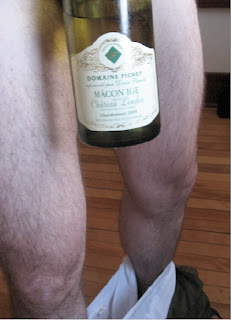Chloe, Helena and me: California split wins big at Café Chloe when I order the dinner special and pour Château Montelena 2005
(MUSIC CREDIT: DJ SHADOW)
This is the first video upload I've ever done on my blog. A fantastic meal matched by an astounding wine were the factors that led me to create it. But it's not a video on the wine or the restaurant per se. Rather, it's a video inspired by them -- these are the scenes that unfolded around me while drinking California's best wine at what must be Southern California's best sidewalk cafe. It's less a gastronomic documentary than it is an interpretation of feeling; less food and wine than twilight mystery developing into the rich, delicious night. It's the Ch Petrogasm of wine video podcasting, if you will.
(By the way, the evocative soundtrack is by California's DJ Shadow, who hails from Davis -- especially suitable since it is the centre of California wine knowledge.)
This comes at a momentous point in time: After I (a) dined at the same restaurant for three consecutive days and (b) finally tasted an American wine that actually made me think seriously about the meaning of the Judgment of Paris.
I can safely say that neither of these things has happened to me before. Until now, I was more of an accidental tourist, never planning to repeatedly return to the same venue while on vacation abroad -- never finding a restaurant with such savvy, yet retaining a keen sense of self (Café Chloe, in San Diego's Gaslamp District, was originally tapped by the inordinately useful Brooklynguy). And also until now, I thought I was the judge on whether I bought New World or Old World wine. Tasting this Napa Valley wine made me think that maybe California was holding all the cards.
So can California cash in on me and make me a repeat player at their table? For a bottle of what I tasted, it's $44.50 in Quebec, and $44.95 in Ontario. In its home state, you'd pay a sommelier some 30-something dollars for a half bottle, which would roughly make the retail price up to $10 cheaper south of the border.
At either pricepoint, this wine is worth it. the wine I am talking about is the Château Montelena Chardonnay Napa Valley 2005. It doesn't just try to be Chablis, it does one better with its own beguiling expressiveness.
But the smart sommelier service I received and the great, truly French approach that Café Chloe demonstrates played their part too, making this a dinner of synergy and total amusement. Château Montelena Chardonnay Napa Valley 2005
Château Montelena Chardonnay Napa Valley 2005
Eyes: As my video suggests, I was taking notes on the Café Chloe sidewalk terrace after dark. The gleaming lights of the San Diego Padres at Petco Park were a feeble twinkle behind Farkas Store Fixtures. No notes on the visuals, sorry.
Nose: Toasty nose. Yeast and brioche with green-tinted fruit.
Mouth: Best of both Worlds? This has a buttery finish on a seriously minerally and citrus-exposed version of Chardonnay. So buttery it seems creamy and sort of oxidized at first (malolactic fermentation?) but it is terrific and worth paying attention to. Strict lines frame a wine with deep, ponderous expression but it's quixotically sharply bracing, with great slaking refreshment. Like the California sea air. Refreshing, but more contemplative than a typical Chablis. And the nice layer of wood or that slight malo hint I get. Dry, lingering, with a balance that makes the the dismount as wonderful as the attack.
Stomach: Café Chloe served me a great dinner plate with loads of local produce, tastefully done and beautifully presented. With the fresh Pacific salmon I had (my first), I was enchanted. Though if I have to honestly say whether tasted more terroir in the fish than in my Chardonnay, I'd single out the drink. While the fish was prepared to perfection, I was let down by (perhaps) overblown promises of Pacific Coast catches, especially the salmon, in this case.
I'd say that salmon's not the ideal match for a clean-lined Chard -- herbed roasted chicken might be the best pairing -- but it didn't matter in the least. The basic building blocks I was given were there. West Coast brilliance!
And my last post said I had to force things in California?
Calistoga, Napa Valley, California, U.S.A. 13.5%.












